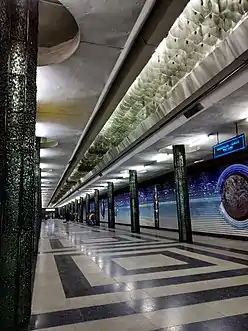Tashkent Metro
The Tashkent Metro (Uzbek: Toshkent metropoliteni) is the rapid transit system serving the city of Tashkent, the capital of Uzbekistan. It was the seventh metro to be built in the former USSR, opening in 1977, and is one of only two subway systems currently operating in Central Asia (the other one being the Almaty Metro). Its stations are among the most ornate in the world, and unlike most ex-Soviet metros, the system is shallow (similar to the Minsk Metro).
 | |
.jpg.webp) A Metrowagonmash 81-718/719 train at Chkalov station in 2004 | |
| Overview | |
|---|---|
| Native name | Toshkent Metropoliteni Ташкентский Метрополитен |
| Owner | State ownership |
| Locale | Tashkent, Uzbekistan |
| Transit type | Rapid transit |
| Number of lines | 4[1] |
| Number of stations | 43[1] |
| Daily ridership | 162,200 (average, 2013) |
| Annual ridership | 59.2 million (2013)[1] |
| Website | https://tashmetro.uz/ |
| Operation | |
| Began operation | 6 November 1977 |
| Operator(s) | Toshkent Metropoliteni |
| Number of vehicles | 168[1] |
| Train length | 4 cars. |
| Technical | |
| System length | 59.5 km (37.0 mi)[1] |
| Track gauge | 1,524 mm (5 ft) |
| Electrification | 825 V DC (third rail) |
| Average speed | 46 km/h (29 mph) |
The Tashkent Metro consists of four lines, operating on 59.5 kilometres (37.0 mi) of route and serving 43 stations.[1] In 2013, the metro carried 59.2 million passengers,[1] which corresponds to a daily average of approximately 162,200 riders.
History
.jpg.webp)
Planning for the Tashkent Metro started in 1968, two years after a major earthquake struck the city in 1966. Construction on the first line began in 1972 and it opened on 6 November 1977 with nine stations. This line was extended in 1980, and the second line was added in 1984. The most recent line is the Circle (Halqa) Line, the first section of which opened in 2020.[2]
A northern extension of this line is currently under construction, and a fourth line was to start construction in 2010, but has been delayed.[3]
Operations
System
The Tashkent Metro comprises of three regular lines and a circle line (under construction) which currently operates 51.4 km of route and serve 38 stations.[1]
The depth of the metro's tunnels varies between 8–25 metres (26–82 ft). The strong construction of these three lines can resist earthquakes of a magnitude of 9.0 on the Richter scale.[4] It sports a 1,520 mm (4 ft 11 27⁄32 in) gauge and a third rail power supply (825 V DC). The average station distance is 1.40 kilometres (0.87 mi).
Lines

- Current lines
| Line | Name | Opened | Length | Stations |
|---|---|---|---|---|
| 1 | Chilonzor Line | 1977 | 23.7 km (14.7 mi) | 17 |
| 2 | Oʻzbekiston Line | 1984 | 14.3 km (8.9 mi) | 11 |
| 3 | Yunusobod Line | 2001 | 10.5 km (6.5 mi) | 8 |
| 4 | Circle[5] (Halqa) Line | 2020 | 11.0 km (6.8 mi) | 7 |
| TOTAL: | 59.5 km (37.0 mi) | 43 | ||
The details of each line is as follows:
Chilonzor Line (red): Construction on this line started in 1968, opened in 1977 between Sabir Rakhimov and Oktyabrinkilobi (Russian: Oktyabr'skoy Revolyutsii, now Amir Temur Khiyoboni) including Novza (Khamza) depot and one metro bridge over Oqtepa channel between Novza (Khamza) and Komsomolskaya stations. It was extended to Maksim Gor'kiy (now Buyuk Ipak Yoli) in 1980 (including another metro bridge over Salar river between Hamid Alimdzhan and Pushkin stations). It is 23.7 kilometres (14.7 mi) long with 17 stations – the planned eastward extension to Traktornyi Zavod (3 stations) was under way but now has disappeared from maps.
Oʻzbekiston Line (blue): The route of this line crosses the city diagonally from northwest to southeast via the Toshkent Railway station. It opened in 1984 and expanded between 1984 and 1991. It is 14.3 kilometres (8.9 mi) long with 11 stations.
Yunusobod Line (green): Work is under way on this line to connect the northern districts to the airport in the south. The first 10.5 kilometres (7 mi) section with 8 underground stations opened for regular service on 24 October 2001 (test runs began on 28 August 2001 – the 10th anniversary of independence, but opening was delayed due to the 9/11 attacks) between Ming Urik (initially planned to be named Lokhutiy) and Habib Abdullayev (now Shahriston).
Circle Line (brown): Construction of new line started in October 2017. In February 2020 it was reported that construction of the first section of the Circle Line from Do'stlik to Qo'yliq stations was finished and that new rolling stock for the Circle Line was undergoing trials. On 30 August 2020, line's first section was opened. It is 11 kilometres (6.8 mi) in length and has six stations.[6] In future, the route will be 52.1 km in length with 35 stations on it.
Stations
Today, the Tashkent Metro has 43 stations that differ from each other. The architecture and décor of each station depicts its name. The peculiarity of the Tashkent metro is its rather shallow station positioning. Some stations have escalators, 7 stations belong to the tower type, 4 stations to the arch type and one station (Mustakillik) to the tower-individual type. Prominent architects and artists of Uzbekistan took part in designing the stations. Interior décor features solid and stable materials: metal (in the form of engravings), glass, plastic, granite, marble, smalt, art ceramics, and carved alabaster. Each station is original work of art and centers on a particular theme. After the break up of the Soviet Union in 1991 many stations were renamed to remove references to Communism.[7][8]
Rolling stock

- Ezh3/Em-508T: 1977–1985.
- 81-717/714: 1980–present.
- 81-718/719: 2001–present.
- 81-717M: 2015–present.
- 81-765.5/766.5/767.5: 2020–present

Like in all Soviet metro systems, the basic type of rolling stock is known as the 81-717/81-714. As of 2013, there are 168 81-717/714 train cars operational on the metro,[1] and they are operated in the form 4-car trainsets serving the system's 100 metres (330 ft) station platforms. Trains have an average commercial speed of 46 kilometres per hour (29 mph). Services started with carriages of type Ezh3 and Em-508T. By the mid 1980s, all these subway cars were given to Baku and Tbilisi metro. In exchange, the metro has received trains of series 81-717/81-714, which are still in service today. In 2001, Tashkent metro has received newer trains of 81-718/719. There were plans to purchase trains of series 81-717.6/714.6 for the metro but that didn't happen. There was a decision to modernize the existing 81-717 trains in the Tashkent Carriage Repair Factory. The first modernized train appeared in 2015. In 2019 new trains of type 81-765/766/767 were ordered for the opening of the Circle line, and with its opening they were given from Uzbekistan line to the Circle line.
Rules and restrictions

It was illegal to take pictures inside the metro system or any of the stations until 31 May 2018 because they were considered military installations due to the system's secondary role as a nuclear bomb shelter.[7] The government under the newly elected Shavkat Mirziyoyev ruled that from 1 June 2018, taking photos is allowed inside the metro.[9][10]
See also
- Trams in Tashkent
- List of rapid transit systems
References
- ОСНОВНЫЕ ТЕХНИКО-ЭКСПЛУАТАЦИОННЫЕ ХАРАКТЕРИСТИКИ МЕТРОПОЛИТЕНОВ ЗА 2013 ГОД. [Main technical and operational specifications for Subways for Year 2013.] (pdf). asmetro.ru (in Russian). Международная Ассоциация "Метро" [International Association of Metros]. 2013. pp. 1, 3. Retrieved 13 May 2014.
- "Notes From Underground: The Tashkent Metro | Steppe". steppemagazine.com. Retrieved 19 June 2019.
- Rohde, Michael. "Tashkent - metrobits.org". mic-ro.com. Retrieved 18 November 2017.
- Горизонт – информационно-аналитический сайт
- Фото, видео: Проект кольцевого метро будет ускорен (Russian)
- "В Ташкенте построены шесть станций кольцевой линии метро" [In Tashkent six stations of the Circle Line have been built] (in Russian). 4 February 2020. Retrieved 5 February 2020 – via Review.uz.
- Chapple, Amos (24 August 2018). "Uzbekistan's secret underground – in pictures". Retrieved 19 June 2019 – via www.theguardian.com.
- Верещагина, Е., Калыбаев, Р. (2020). "Гид по архитектуре и культуре Ташкента: как город открывается миру и придумывает себя" (in Russian). Daily Afisha. Retrieved 19 February 2020.CS1 maint: multiple names: authors list (link)
- "Transport in/to/from Tashkent – Metro". Caravanistan. Retrieved 18 November 2017.
- Uzbekistan's Secret Underground Radio Free Europe/Radio Liberty (www.rferl.org). Retrieved on 16 August 2018.
External links
- Tashkent Metro track map
- article at msn.com
- article, with images at advantour.com
- BBC Travel website – report on the Tashkent Metro
- New York Times Article with subway photos
| Wikimedia Commons has media related to Tashkent Metro. |